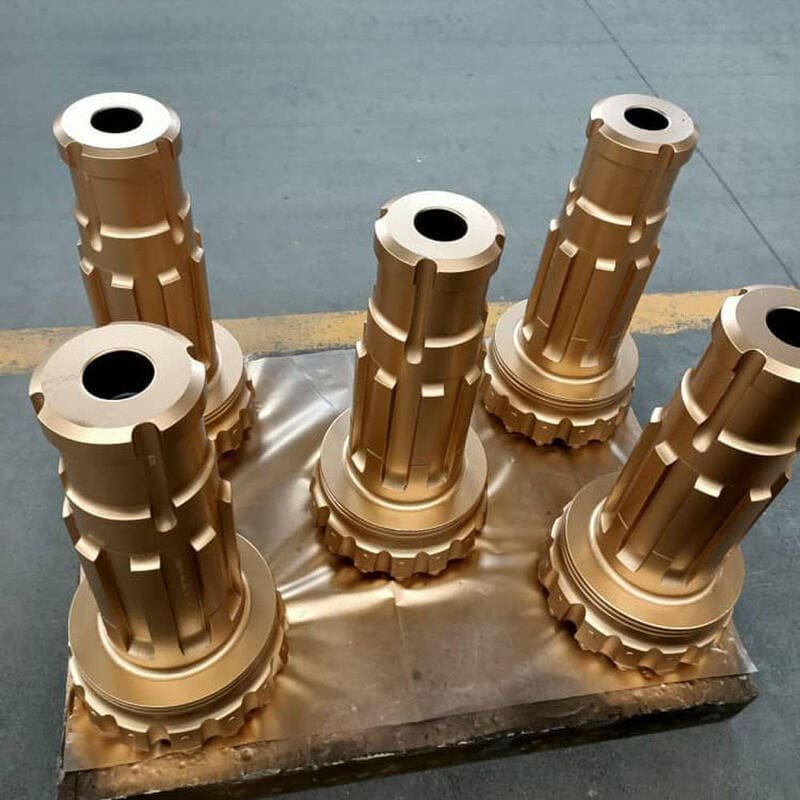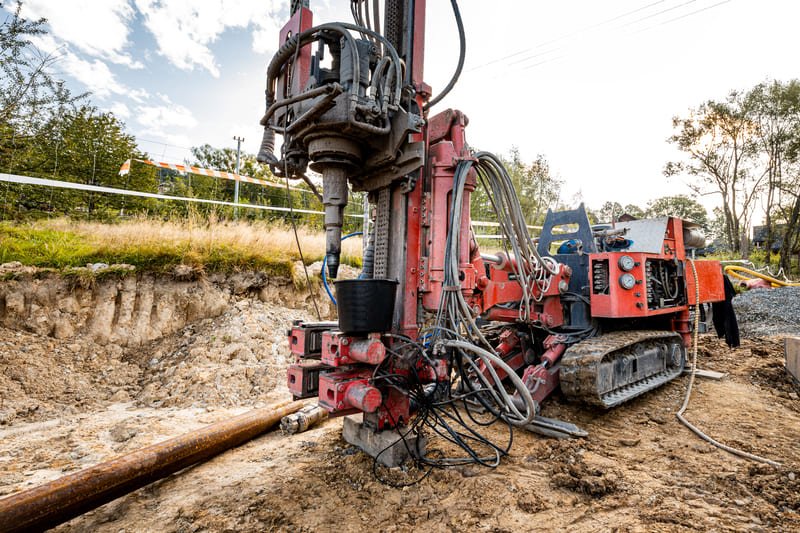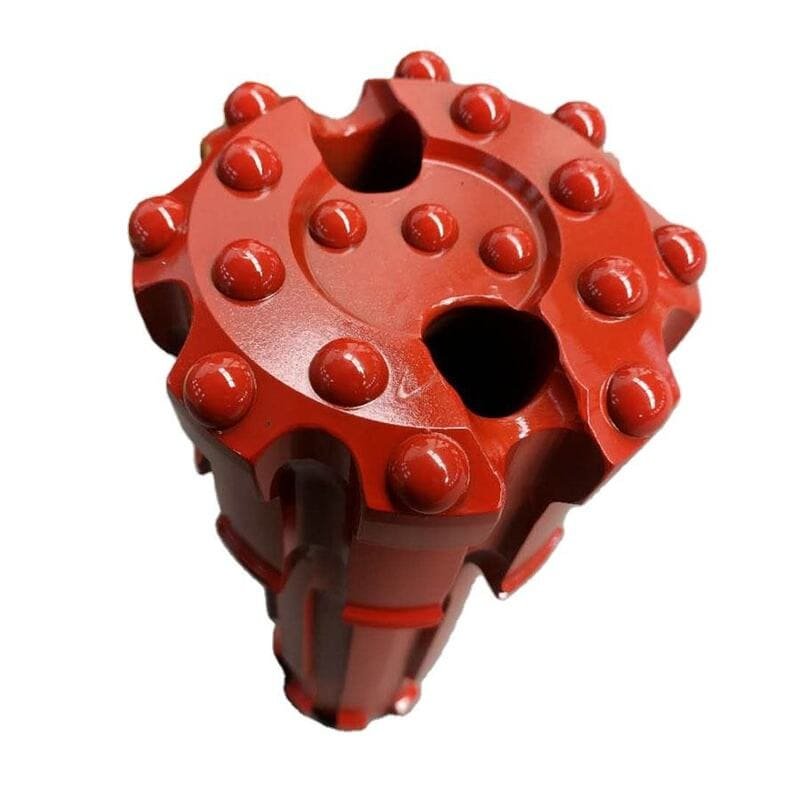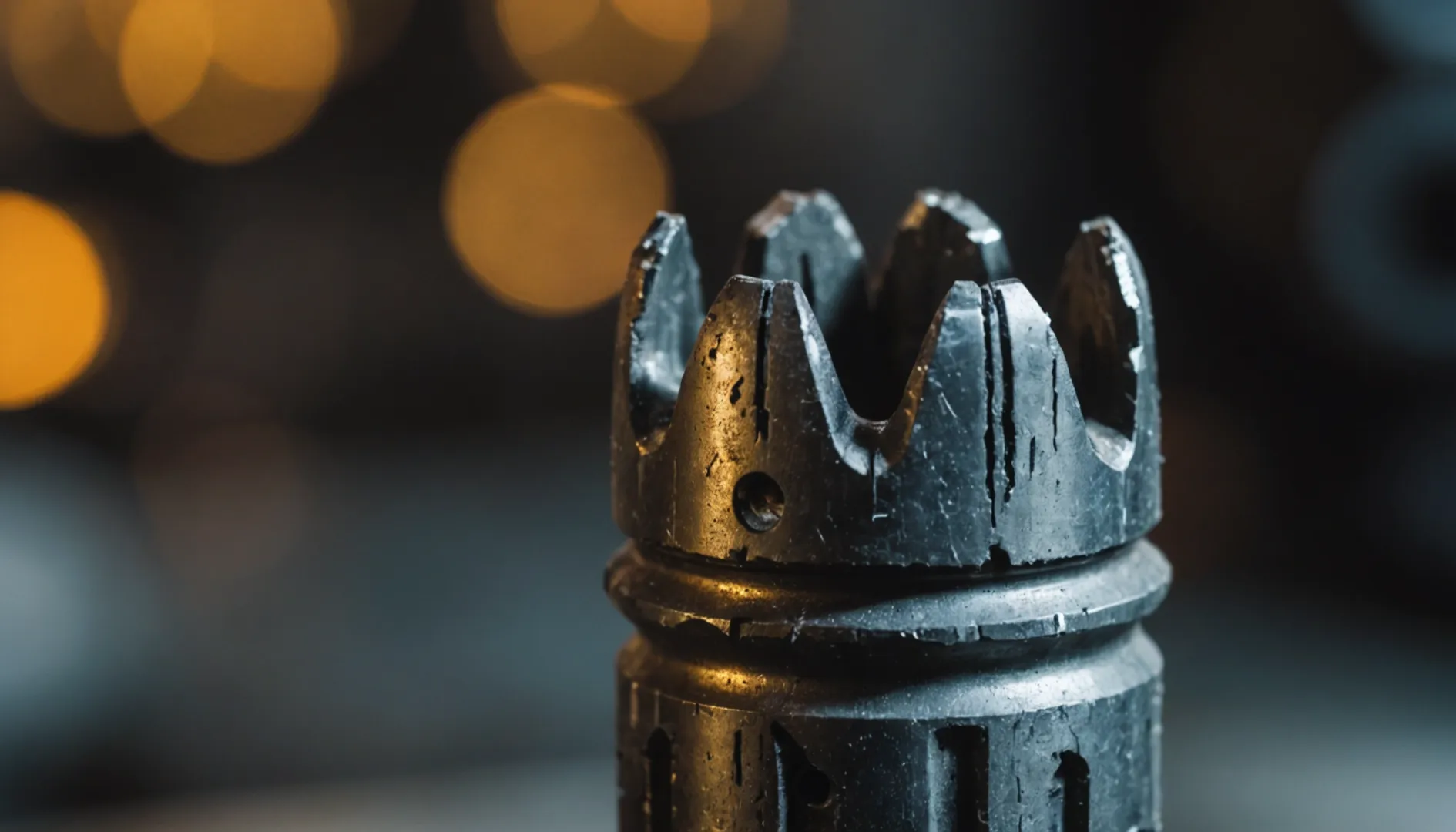Ever felt like your DTH drill bits are in a constant battle against the elements?
DTH drill bits often face challenges such as wear and damage, performance inefficiencies, hydraulic problems, and operational hiccups. Tackling these issues involves choosing the right bit, performing regular maintenance, and adjusting drilling parameters correctly.
When I first started working with DTH drill bits, it was like trying to solve a puzzle where the pieces kept changing shape. Understanding the core challenges gave me a sense of relief, like finally finding that missing puzzle piece under the couch. This guide will walk you through each issue, offering strategies I wish I'd known earlier to keep your drilling operations running smoothly and efficiently.
Chipped teeth are caused by dynamic impacts.True
Dynamic impacts exert side forces, leading to chipped teeth.
Bit balling occurs in hard rock formations.False
Bit balling happens in soft, sticky formations with water-based mud.
How Can I Spot Bit Wear and Damage Early?
Ever felt the panic of a failing drill bit mid-project? Discover how to catch bit wear early and keep your operations running smoothly.
I regularly inspect my drill bits for chipped teeth, uneven wear, and signs of overheating. Using monitoring tools and ensuring proper lubrication helps me catch bit issues before they escalate.

Recognizing Physical Signs of Wear
Honestly, one of the most nerve-wracking moments I've experienced was when I noticed my drill bit struggling halfway through a project. Since then, I've made it a habit to perform regular physical checks. I look for things like chipped or broken teeth, which often result from side forces or unexpected impacts. Uneven wear can be a dead giveaway that something's not right, possibly pointing to misalignment1 or uneven rock formations. Catching these signs early has saved me from a lot of headaches down the line.
Monitoring Drilling Performance
Keeping an eye on how my drilling operation performs is another way I stay ahead of bit wear. If I notice slower penetration rates or that nagging feeling when speeds just aren't cutting it, it's often a dull bit to blame. The "running drilling" phenomenon, where the drill deviates from its intended path, is another red flag. Regularly monitoring these aspects ensures I'm on top of any issues before they cause major disruptions.
Utilizing Advanced Technology
Advanced tech has become my go-to for pinpointing early signs of wear. Tools like vibration analysis and thermal imaging have transformed how I approach maintenance. Vibration analysis helps me detect misalignments or worn parts causing excessive vibration, while thermal imaging highlights overheating problems2 due to insufficient cooling. Incorporating these technologies has been a game-changer in my routine checks.
Importance of Lubrication and Cooling
I can't stress enough the importance of proper lubrication and cooling. These elements are crucial in preventing premature wear. I've learned the hard way that insufficient lubrication can speed up component wear, while lack of cooling can lead to overheating. Regular checks and adjustments according to manufacturer guidelines have become second nature to me.
The Role of Operator Training
Training is key in identifying signs of wear early. I make sure to understand subtle changes in drilling performance and the implications of unusual noises. Knowing when to halt operations for a detailed inspection has been vital in catching potential issues before they escalate into major setbacks. Adequate training means I'm always ready to tackle challenges head-on.
By combining these strategies—regular inspections, performance monitoring, advanced technology, and thorough training—I've been able to maintain efficient and uninterrupted drilling operations. This proactive approach not only saves time but also keeps costs down by avoiding unexpected downtimes.
Chipped teeth always indicate incorrect bit selection.False
Chipped teeth can result from side forces or impacts, not just bit selection.
Plugged nozzles increase standpipe pressure in drilling.True
Plugged nozzles restrict flow, causing pressure buildup in the standpipe.
What Are the Best Practices for Improving Drilling Performance?
Ever wondered how to make drilling smoother and more efficient? I've been there too, trying to crack the code for better performance. Let's dive into some game-changing practices that can transform your drilling operations.
To enhance drilling performance, focus on picking the right drill bit, keeping equipment in top shape, fine-tuning drilling parameters, and ensuring proper alignment. Regular checks based on the formation type are vital. Implementing these strategies can lead to more efficient, cost-effective drilling operations.

Selecting the Right Drill Bit
Imagine this: you're in the middle of nowhere, with nothing but rocks all around and your drill bit starts acting up. I remember a time when we were drilling through a particularly tough formation and the wear on our bits was just insane. Choosing the right drill bit, especially for hard formations, is like choosing the right shoes for a marathon. It can save you a ton of headache and costs down the line. Keep an eye out for wear patterns and make sure to replace those chipped or broken teeth before they become a bigger problem. Consider factors like the type of formation and expected wear patterns. For instance, choosing bits3 specifically designed for hard formations can reduce wear and damage.
Regular Equipment Maintenance
There was this one summer when our team decided to skip some routine checks thinking it would save us time. Big mistake. We ended up losing more days dealing with equipment failures. Trust me, maintaining your gear is like keeping your car in check—regular inspections prevent those nasty surprises. Stick to the manufacturer's guidelines for servicing parts like hammers and seals. Your future self will thank you. Routine maintenance of drilling equipment is essential to prevent unexpected downtimes, including inspecting components like the hammer, seals, and connections for wear or damage as per manufacturer guidelines4.
Optimizing Drilling Parameters
Adjusting drilling parameters felt like trying to tune an old radio when I first started out. Weight on bit, rotation speed, air pressure—they all matter depending on what you're drilling into. I learned that using real-time monitoring systems can make a world of difference. It's like having an extra pair of eyes ensuring you're on the right track. Adjust parameters such as weight on bit according to formation type; utilize real-time monitoring systems5 to dynamically adjust parameters.
Ensuring Proper Alignment
Misalignment can be a silent performance killer. I remember one project where everything seemed off, and it turned out to be just an alignment issue. Regular checks using advanced alignment tools can keep your drill string perfectly aligned, preventing costly deviations and equipment wear. Implementing advanced alignment tools6 assists in maintaining precision.
Adequate Flushing and Cooling
I once faced a situation where our bit overheated because we underestimated the importance of proper flushing. Ensuring your nozzles are clear and flushing systems work optimally helps avoid overheating and regrinding of cuttings—it’s like making sure your computer doesn’t overheat by regularly cleaning it. Ensure that nozzles are clear of obstructions and that flushing systems7 operate at optimal levels.
Chipped teeth occur only in soft formations.False
Chipped teeth can occur in any formation due to side forces or impacts.
Proper bit selection reduces premature wear.True
Choosing the right bit for the formation prevents excessive wear and damage.
How Do Hydraulic Issues Affect DTH Drill Bits?
When my drilling rig started acting up, I couldn't ignore the tell-tale signs of hydraulic issues causing havoc on my DTH drill bits.
Hydraulic issues can wreak havoc on DTH drill bits by causing wear and reducing penetration rates due to compromised fluid flow and pressure. Addressing these problems requires careful attention to hydraulic design and consistent maintenance.

Impact on Bit Wear and Damage
Hydraulic issues can accelerate the wear and tear of DTH drill bits. I remember the frustration of discovering chipped teeth on my drill bit after a long day in the field. It was like the bit had been through a rock-and-roll concert, banging against hard formations with uneven pressure. These hydraulic hiccups not only wore out the bit but also led to premature component wear when proper lubrication was missing.
High-velocity mud flow, without proper hydraulic control, felt like it was sandblasting the bit into oblivion, thanks to poor hydraulic control. This occurs when entrained cuttings continuously strike the drill bit, leading to a loss in its structural integrity.
Drilling Performance Issues
Hydraulic systems are crucial for maintaining optimal drilling performance. The day my rig lost air pressure mid-operation is etched in my memory. The penetration rate slowed to a crawl, and it felt like trying to drill through solid steel with a butter knife. It turned out that hydraulic malfunctions were dulling the bits faster than I could replace them.
Furthermore, phenomena like "running drilling"—a nightmare where the drill pipe bent—threatened to derail the whole project. Regular maintenance became my mantra to avoid such headaches.
Loss of impact power is another consequence of hydraulic issues. Worn internal components may not be able to withstand the drilling process, leading to reduced efficiency.
Operational Challenges
One time, my hammer got stuck due to debris—talk about a day gone wrong! This was all due to a misalignment in the hydraulic system, causing excessive vibration and noise. It was a wake-up call about how crucial it is to keep an eye on those seals and connections.
Air leakage from damaged seals or loose connections often results from improper hydraulic maintenance. This leakage can severely affect drilling operations by reducing the air pressure necessary for optimal function.
Formation-Specific Concerns
Drilling through fractured rock formations is like navigating a maze blindfolded. The drill bit jammed several times due to hydraulic failures, making it nearly impossible to maintain hole straightness.
Transitions between different rock types added another layer of complexity that required precise hydraulic control—a lesson learned the hard way.
To overcome these challenges, adjusting drilling parameters8 became essential—a lesson learned through experience. Staying informed with real-time data from hydraulic systems became my best ally in ensuring efficient drilling operations.
In conclusion, keeping a close watch on hydraulic designs9 and conducting regular maintenance checks became second nature. Proper flushing and alignment while maintaining adequate air pressure drastically reduced the impact of these hydraulic gremlins on my drilling operations.
Chipped teeth occur due to side forces.True
Side forces during drilling can chip bit teeth, reducing efficiency.
High-velocity mud prevents bit erosion.False
High-velocity mud actually causes bit erosion by carrying cuttings.
What Are the Typical Operational Challenges in DTH Drilling?
Have you ever faced unexpected hiccups while drilling that left you scratching your head?
Common operational challenges in DTH drilling include bit wear, drilling performance issues, hydraulic problems, hammer jamming, and maintaining hole straightness.

Bit Wear and Damage
I remember my first encounter with bit wear. It was a chilly morning, and I was halfway through a project when I noticed the teeth of the bit were chipped and broken. It turned out that we had hit an unexpectedly hard formation. It's one of those moments where you feel a mix of frustration and determination. To prevent future setbacks like this, I've learned that choosing the right bit and ensuring proper alignment can make a world of difference.
In DTH drilling, bit wear and damage are frequent hurdles. Chipped or broken teeth can result from dynamic impacts or drilling through hard formations. Uneven wear might occur due to irregular rock formations or misalignment of the drilling rig. To mitigate these issues, selecting the appropriate bit and maintaining proper alignment are crucial.
Drilling Performance Issues
On another job, we faced a painfully slow penetration rate. The drill seemed sluggish, and my heart sank every time I checked the progress. I realized later that our bit was dull and not quite right for the rock type we were tackling. Plus, our air pressure wasn't up to par. It was a classic case of "running drilling," where everything just feels off. Now, I make sure to keep the bits sharp and maintain regular equipment checks.
Drilling performance can suffer due to dull bits, incorrect bit type for the formation, or insufficient air pressure. This can lead to slow penetration rates and increased operational costs. The phenomenon known as "running drilling" may also occur, where the drill hole deviates from the intended path, potentially bending the DTH drill pipe. Regular maintenance and correct parameter settings are essential to enhance performance.
Hydraulic-Related Problems
The sound of a clogged nozzle is something I'll never forget—it was a screeching reminder of my oversight in hydraulic management. Using water-based mud in sticky formations caused our bit to ball up, which was a nightmare. We also experienced high-velocity mud erosion at another site. Since then, I've been extra vigilant about our hydraulic systems to avoid those headaches.
Hydraulic issues in DTH drilling often include bit balling, erosion, and plugged nozzles. These problems can arise from poor hydraulic design or unsuitable mud types. For instance, using water-based mud in sticky formations can cause the bit to ball up while high-velocity mud can lead to erosion. Proper hydraulic management is vital for maintaining equipment integrity.
Hammer Jamming and Vibration
Hammer jams are the worst! There was this one time when debris got lodged in the hammer during a crucial phase of drilling. The misalignment just compounded the problem leading to excessive vibration. It taught me a valuable lesson about the importance of stabilizers10 and precise alignment.
Hammer jamming due to debris or rock fragments is another common problem that can result from misalignment or excessive backpressure. Moreover, excessive vibration or noise may occur if components are worn or unbalanced.
Formation-Specific Challenges
Drilling through fractured rock is like navigating a maze blindfolded; on one project we had to constantly adjust drilling parameters as we moved between different rock types—an endless cycle of tweak-and-adjust trying to maintain hole straightness amidst unexpected jams.
Drilling through fractured rock formations presents unique challenges like jamming of the drill bit or difficulty maintaining hole straightness transitioning between different rock types exacerbates these problems requiring careful adjustment11 of drilling parameters to maintain efficiency.
Overheating and Flushing Problems
Imagine the smell of overheating metal—it’s a scent that sticks with you! We once had improper cooling leading significant overheating issues coupled with inadequate flushing causing regrinding since then I've made sure our cooling flushing systems top-notch keep things running smoothly.
Overheating due improper drilling parameters insufficient cooling frequent issue additionally inadequate removal drill cuttings lead regrinding reduced efficiency ensuring adequate flushing12 cooling systems essential preventing overheating improving cuttings removal efficiency.
Chipped teeth occur only in soft formations.False
Chipped teeth can occur in hard formations due to side forces.
Bit erosion is caused by high-velocity mud.True
High-velocity mud with entrained cuttings leads to bit erosion.
How Does Formation Type Impact DTH Drilling Efficiency?
When I first encountered the complexities of DTH drilling, I realized how much the ground beneath us dictates our success.
Formation type impacts DTH drilling efficiency by influencing bit wear, drilling speed, and hydraulic performance. Different rock characteristics require specific bit selections and operational adjustments to maintain optimal drilling conditions. Adapting techniques to formation type helps mitigate issues like bit damage and inefficient penetration rates.

Bit Wear and Durability
I've learned the hard way that the type of rock we drill into plays a huge role in how long our bits last. Hard rock, for instance, can be merciless, often chipping or even breaking the teeth of our drill bits. I remember one particular project where the bits just couldn't withstand the constant pounding; it was like trying to bite through a diamond with your teeth! For softer formations, it's a different story. Imagine trying to peel a sticker off without it sticking to your fingers—sticky materials often ball up on the bit, which can seriously slow down cutting efficiency. Choosing the right bit for each type of rock is crucial to avoid premature wear13.
Drilling Performance Variations
Each rock formation brings its own set of challenges and quirks. In hard formations, I've had to crank up the air pressure and use specialized bits just to make a dent. On the flip side, softer rocks might seem like an easy target but can cause their own headaches, like "running drilling," where the drill veers off course. It's kind of like driving on ice—you need to adjust your speed and direction constantly. Tweaking air pressure and rotation speed based on the rock type can make all the difference in penetration efficiency14.
Hydraulic Efficiency Challenges
Hydraulics can be another tricky area influenced by formation types. In soft formations, I've seen bits get clogged up with sticky mud, while in tougher rocks, high-velocity mud can lead to nozzle blockages. It reminds me of trying to drink a thick milkshake through a straw—frustratingly slow! Ensuring proper mud flow and adjusting hydraulic settings for each formation type is essential for optimal hydraulic performance15.
Operational Adjustments for Formation Specifics
Switching between different rock types can be like navigating a maze. In highly fractured zones, maintaining a straight drilling path is challenging; tools can get jammed if you're not careful. On one memorable occasion, I thought we'd lost our drill entirely! Using stabilizers and keeping everything aligned is key. Regular maintenance and precise adjustments to match each formation type help keep everything under control during drilling operations16.
Chipped teeth occur only in soft formations.False
Chipped teeth can occur in hard formations due to side forces.
Bit balling is caused by water-based mud in sticky formations.True
Water-based mud can cause bit balling in soft, sticky formations.
How Can I Prevent My DTH Drill Bits from Overheating?
Ever felt the frustration of drill bits overheating mid-project? You're not alone. Let's explore how to keep those DTH drill bits cool and efficient.
To keep DTH drill bits from overheating, it's essential to use proper lubrication, maintain the right drilling speed, and ensure adequate air pressure. Routine maintenance and selecting the correct bit for the job are also key. These steps help manage heat, extend bit life, and boost performance.

Understanding the Causes of Overheating
Overheating in DTH (Down-The-Hole) drill bits is often the result of improper drilling parameters or insufficient cooling. Factors such as excessive drilling speed17 and inadequate lubrication contribute significantly to heat build-up. Understanding these causes allows drill operators to make informed adjustments.
I remember my first drilling project where I underestimated the impact of overheating. It was a hot day, and I thought I was ready. But just hours in, my DTH drill bit started acting up. This frustrating experience taught me that overheating often stems from improper drilling parameters or insufficient cooling.
The Role of Lubrication
Lubrication is vital for reducing friction and heat. Utilizing high-quality lubricants can ensure smoother operation of the drill bit, minimizing wear. Regularly checking and applying appropriate lubricants18 prevents excessive heat from damaging the bit.
From that day forward, lubrication became my best friend in drilling projects. I learned that using high-quality lubricants reduced friction and heat, making operations much smoother.
Importance of Correct Bit Selection
Choosing the correct drill bit for the rock formation is essential. A mismatched bit can cause excessive friction, leading to overheating. Ensuring you have the right bit type19 for specific formations not only enhances performance but also reduces thermal stress.
Picking the right drill bit for the rock formation is like choosing the right shoes for a hike—it makes a world of difference.
Optimizing Drilling Parameters
Adjusting parameters like weight on bit, rotation speed, and air pressure can effectively manage heat levels. For instance, slower speeds might be necessary in harder formations to prevent overheating. Optimal parameter settings20 depend on specific conditions and require careful monitoring.
I've learned that adjusting parameters like weight on bit, rotation speed, and air pressure can be game changers in managing heat levels.
Enhancing Cooling with Sufficient Air Pressure
Proper air pressure ensures effective cooling and debris removal during drilling operations—think of it as your bit's personal air conditioning system. Insufficient air pressure can lead to poor cooling, causing the bit to overheat. Regular checks of air pressure systems21 help maintain efficient cooling processes.
Regular Maintenance Practices
Routine maintenance checks help identify potential issues that could lead to overheating. Inspecting components like seals and connections for air leaks or damage ensures that the cooling system operates effectively, maintaining optimal drill performance22.
Routine maintenance has saved me from countless headaches by ensuring efficient operation.
Proper bit selection prevents overheating.True
Choosing the correct bit reduces friction and heat generation.
High drilling speed reduces bit wear.False
Excessive speed increases friction, leading to faster wear.
Conclusion
DTH drill bits face challenges like wear, hydraulic issues, and performance inefficiencies. Proper bit selection, maintenance, and parameter adjustments are essential for efficient drilling operations.
-
Learn corrective measures for misaligned drilling rigs. ↩
-
Discover strategies to avoid overheating in drill bits. ↩
-
Discover which drill bits work best for hard formations. ↩
-
Follow manufacturer guidelines for effective equipment maintenance. ↩
-
Learn about systems that help optimize drilling parameters. ↩
-
Explore tools that aid in maintaining drill alignment. ↩
-
Understand how efficient flushing systems improve drilling. ↩
-
Discover how to optimize drilling parameters effectively. ↩
-
Learn about common causes of uneven bit wear. ↩
-
Discover how stabilizers prevent vibration and improve hole accuracy. ↩
-
Learn how to optimize parameters for varied geological conditions. ↩
-
Understand how proper flushing enhances debris removal efficiency. ↩
-
Learn optimal drill bit selection for different geological conditions. ↩
-
Discover methods to enhance penetration efficiency in drilling. ↩
-
Understand hydraulic adjustments for efficient drilling operations. ↩
-
Find strategies for maintaining alignment in diverse formations. ↩
-
Learn how adjusting speed can prevent overheating issues. ↩
-
Discover top lubricants to reduce friction and heat. ↩
-
Choose the best bit type for optimal performance. ↩
-
Find tips on setting optimal drilling parameters. ↩
-
Understand why air pressure is crucial for cooling. ↩
-
Explore maintenance tips to enhance drill longevity. ↩








